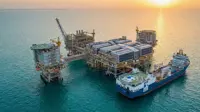Third assessment report on Impact of climate change in India released
09 May 2008
The Earth's surface temperature has increased by 0.6+0.2o C over the 20th century, says the third assessment report (TAR) of the inter-governmental panel on climate change (IPCC).
According to the report estimates that the global mean sea level has rising at the rate of 1 to 2 mm annually during the 20th century. The report projects that globally averaged surface temperature would rise by 1.4 to 5.8o C and the global mean sea level may rise by 0.09m to 0.88m during 1990 - 2100.
Highlights of third assessment report:
Impact of climate change on water resources
- It is projected that quantity of surface run off due to climate change would vary across the river basis as well as sub-basins of major rivers.
- However, there is a general reduction in the quantity of the available run off.
Impact of climate change on a griculture in India
- Variable Impactof climate change on agriculture have been projected.
- A mixed projection of yields of various crops across regions.
- No definite trends have yet been established.
Impactof climate change on forestry and natural ecosystem
- Forests are projected to be vulnerable.
- Biodiversity is also likely to be adversely impacted due to this.
Impact of climate change on human health
- Increase in vector borne diseases such as Malaria in areas not reported earlier.
Impact of climate change of infrastructure
- Large infrastructure such as dams, roads, bridges incurring high costs of constructions are vulnerable to extreme events like cyclones, heavy rains, land slides and floods, which may increase in the later half of the century due to climate change.
Impact of climate change on coastal zones in India
- To holistic data of sea level reveals a high variability along the Indian Coastline with an increase along Gulf of Kutchh and West Bengal coastline and decrease along Karnataka coast.
- The observation indicate a long term average rising trend of 1mm/year in sea level and a projection of rise in sea level in the range of 46-59 cm by the end of twenty first century.
India is a party to the United Nations framework convention on climate change (NUFCCC), adopted in 1992 and became effective on 21 March 1994. The convention aims to stabilise the concentration of greenhouse gases in the atmosphere at a level that would prevent dangerous anthropogenic interference with the climate system within a time frame sufficient to allow the ecosystems to adapt naturally to climate change, to ensure that food production is not threatened and to enable economic development to proceed in a sustainable manner.






















